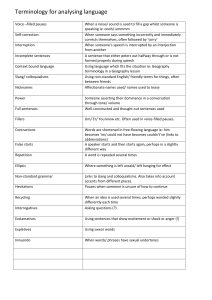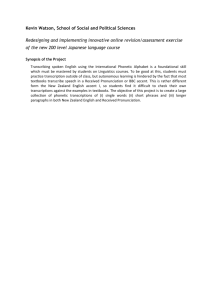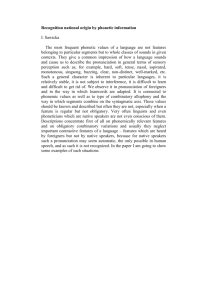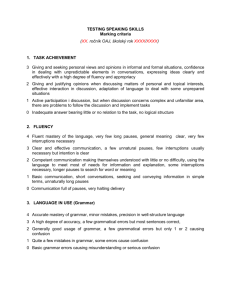1 - mglukp.narod.ru
advertisement
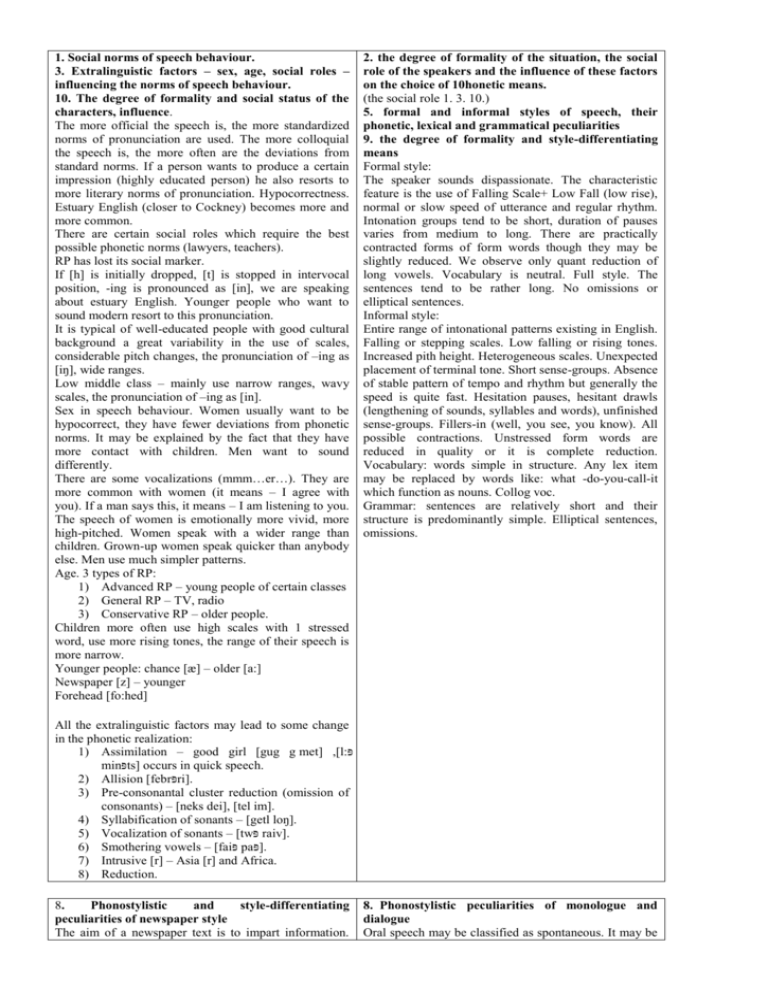
1. Social norms of speech behaviour. 3. Extralinguistic factors – sex, age, social roles – influencing the norms of speech behaviour. 10. The degree of formality and social status of the characters, influence. The more official the speech is, the more standardized norms of pronunciation are used. The more colloquial the speech is, the more often are the deviations from standard norms. If a person wants to produce a certain impression (highly educated person) he also resorts to more literary norms of pronunciation. Hypocorrectness. Estuary English (closer to Cockney) becomes more and more common. There are certain social roles which require the best possible phonetic norms (lawyers, teachers). RP has lost its social marker. If [h] is initially dropped, [t] is stopped in intervocal position, -ing is pronounced as [in], we are speaking about estuary English. Younger people who want to sound modern resort to this pronunciation. It is typical of well-educated people with good cultural background a great variability in the use of scales, considerable pitch changes, the pronunciation of –ing as [iŋ], wide ranges. Low middle class – mainly use narrow ranges, wavy scales, the pronunciation of –ing as [in]. Sex in speech behaviour. Women usually want to be hypocorrect, they have fewer deviations from phonetic norms. It may be explained by the fact that they have more contact with children. Men want to sound differently. There are some vocalizations (mmm…er…). They are more common with women (it means – I agree with you). If a man says this, it means – I am listening to you. The speech of women is emotionally more vivid, more high-pitched. Women speak with a wider range than children. Grown-up women speak quicker than anybody else. Men use much simpler patterns. Age. 3 types of RP: 1) Advanced RP – young people of certain classes 2) General RP – TV, radio 3) Conservative RP – older people. Children more often use high scales with 1 stressed word, use more rising tones, the range of their speech is more narrow. Younger people: chance [æ] – older [a:] Newspaper [z] – younger Forehead [fo:hed] 2. the degree of formality of the situation, the social role of the speakers and the influence of these factors on the choice of 10honetic means. (the social role 1. 3. 10.) 5. formal and informal styles of speech, their phonetic, lexical and grammatical peculiarities 9. the degree of formality and style-differentiating means Formal style: The speaker sounds dispassionate. The characteristic feature is the use of Falling Scale+ Low Fall (low rise), normal or slow speed of utterance and regular rhythm. Intonation groups tend to be short, duration of pauses varies from medium to long. There are practically contracted forms of form words though they may be slightly reduced. We observe only quant reduction of long vowels. Vocabulary is neutral. Full style. The sentences tend to be rather long. No omissions or elliptical sentences. Informal style: Entire range of intonational patterns existing in English. Falling or stepping scales. Low falling or rising tones. Increased pith height. Heterogeneous scales. Unexpected placement of terminal tone. Short sense-groups. Absence of stable pattern of tempo and rhythm but generally the speed is quite fast. Hesitation pauses, hesitant drawls (lengthening of sounds, syllables and words), unfinished sense-groups. Fillers-in (well, you see, you know). All possible contractions. Unstressed form words are reduced in quality or it is complete reduction. Vocabulary: words simple in structure. Any lex item may be replaced by words like: what -do-you-call-it which function as nouns. Collog voc. Grammar: sentences are relatively short and their structure is predominantly simple. Elliptical sentences, omissions. All the extralinguistic factors may lead to some change in the phonetic realization: 1) Assimilation – good girl [gug g met] ,[l:פּ minפּts] occurs in quick speech. 2) Allision [febrפּri]. 3) Pre-consonantal cluster reduction (omission of consonants) – [neks dei], [tel im]. 4) Syllabification of sonants – [getl loŋ]. 5) Vocalization of sonants – [tw פּraiv]. 6) Smothering vowels – [fai פּpa]פּ. 7) Intrusive [r] – Asia [r] and Africa. 8) Reduction. 8. Phonostylistic and style-differentiating peculiarities of newspaper style The aim of a newspaper text is to impart information. 8. Phonostylistic peculiarities of monologue and dialogue Oral speech may be classified as spontaneous. It may be This aim presupposes that intonational peculiarities should serve the aim. The information should be clear. The following phonetic features: 1. The tempo of speech is moderate and usually stable. Parenthetic elements are read quicker. 2. The division into sense-groups depends on the meaning of the text. The division is very distinct, sensegroups are long (4-5 stressed syllables). 3. Scales are mainly descending. Tones are mainly falling (they sound sharp and very categoric). 4. Singling out the communicative centers of sensegroups is achieved mainly by decentralized stressing (each semantically important word is singled out). 5. Each sense-group may be separated by a pause. At the end of a paragraph there is a rather long pause. 6. Medium range. 7. The tembre of speaker’s voice is unchangeable. both monological and dialogical. Peculiarities of monologues and dialogues: 1) A lot of elliptical sentences (usually the subject is omitted). 2) A lot of non-finished sentences and repetitions. Peculiarities of intonation in dialogues: 1) A great number of sense-groups, they are very short (2 semantically important words). In monologues there may be longer sense-groups. 2) Tones are falling. Complex tones are very common. 3) The melodical contour is diverse. It may have different movements. Wavy (heterogeneous) scales. 4) Medium range. If a passage is emphatic, the range is wider. 5) Both centralized and decentralized stressing is used. Decentralized stressing is used mainly in monological elements. 6) The tempo of speech depends on the situation. If we compare the reading of a written dialogical text to actual dialogue – the reading is quicker. (When you speak, you think about what you are going to say next.) 7) Lots of pauses. Sometimes the length of pauses is equal to 50 %. Pauses may be of different character. Hesitation pauses are most common (they precede some information which the speaker thinks over). 8) The tembre of speech may be used artistically.

